Tea tree oil was once a well-kept secret of the aborigines of Australia. The natives used it for more than a century to treat coughs and colds as well as heal a number of topical infections and diseases.
Numerous studies have been carried out worldwide to understand the strong antibacterial nature of tea tree oil, with most of them confirming its efficacy as a ‘cure-all’ oil. For this reason, tea tree oil is now being used in a number of antibacterial skin and hair care products. Not just that, even medical practitioners are now trying it out for its therapeutic benefits in healing and preventing bacterial infections.

To understand further what this natural extract is capable of, read on to learn how you can use tea tree oil for bacterial infections.
Contents
- Treat Bacterial Infections with Tea Tree Oil
- Tips to use tea tree oil for bacterial infections
Treat Bacterial Infections with Tea Tree Oil
There are a number of bacterial infections that can be cured with tea tree oil.
Method 1: Bacterial Vaginosis
Tea tree oil can bring relief from any vaginal infection caused by bacteria. A bacterial infection, also known as bacterial vaginosis, is caused by an imbalance of the natural flora of the vagina. (1) The condition can be easily treated using tea tree oil diluted with a carrier oil, such as almond or olive oil.
Things you’ll need:
- Tea tree essential oil (antibacterial) – 1 or 2 drops
- Olive oil (carrier oil) – 1 tablespoon
Single-Step Treatment: Dilute tea tree oil with olive oil & apply it around the vagina
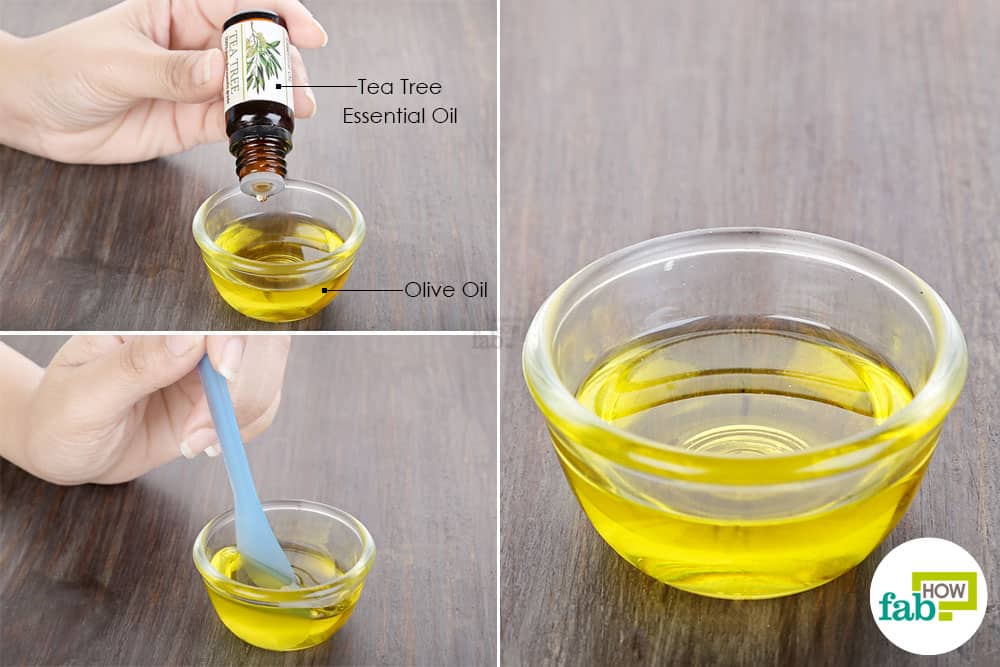
- Mix 1 or 2 drops of tea tree oil into 1 tablespoon of olive oil. You may increase the quantity of tea tree oil on the second day, once you become comfortable with the burning sensation that occurs upon contact with the sensitive skin around the vagina.
- Soak a cotton ball in the solution and swab it around your vagina.
- Let it sit for 6 to 8 hours, then reapply.
- Alternatively, you can soak a tampon in the solution and insert it into the vagina for 1 hour.
This oil blend will bring you relief after just a few hours of application. The foul smell will also be gone for good. Continue to use the remedy twice daily to get rid of the infection in 1 week.
Method 2: Acne
Tea tree oil is an age-old remedy for treating acne. Its antibacterial properties help kill the bacteria causing the breakouts. It’s also anti-inflammatory and will help reduce the pain and inflammation of acne.
A 2017 pilot study published in the Australasian Journal of Dermatology states that using tea tree oil-based products helped improve mild and moderate acne without any ill effects. (2)
Since tea tree oil is a very strong oil, dilute it with aloe vera gel. Aloe vera gel will also help form an antibacterial layer on the skin and soothe the inflamed skin. Plus, the gel will help prevent the formation of acne scars.
Things you’ll need:
- Tea tree essential oil (antibacterial and anti-inflammatory) – 3 or 4 drops
- Fresh aloe vera gel (soothing and healing) – 2 teaspoons
Single-Step Treatment: Apply a blend of aloe vera gel and tea tree oil on your acne

- Mix 3 or 4 drops of tea tree essential oil into 2 teaspoons of fresh aloe vera gel. You can even learn how to make your own aloe vera gel.
- Use a cosmetic brush to apply the blend to your face.
- Keep it on for 10 to 15 minutes, then wash it off with warm water.
- Gently pat dry your skin with a soft towel.
Use this face mask every 2 or 3 days to get rid of acne.
Method 3: Dandruff
Both dandruff and the resulting itchy scalp can be an embarrassment for the sufferer. Tea tree oil can help deal with the infection that is turning your scalp flaky and causing the uncontrollable itchiness. (6)
You’ll need to dilute the tea tree oil with coconut oil before massaging your scalp with it. Coconut oil is also an antibacterial agent and will help moisturize the scalp and soothe the itching, too.
Things you’ll need:
- Tea tree essential oil (antibacterial) – 10 drops
- Coconut oil (anti-inflammatory) – 1 tablespoon
Single-Step Treatment: Dilute tea tree oil with coconut oil & massage your scalp with it
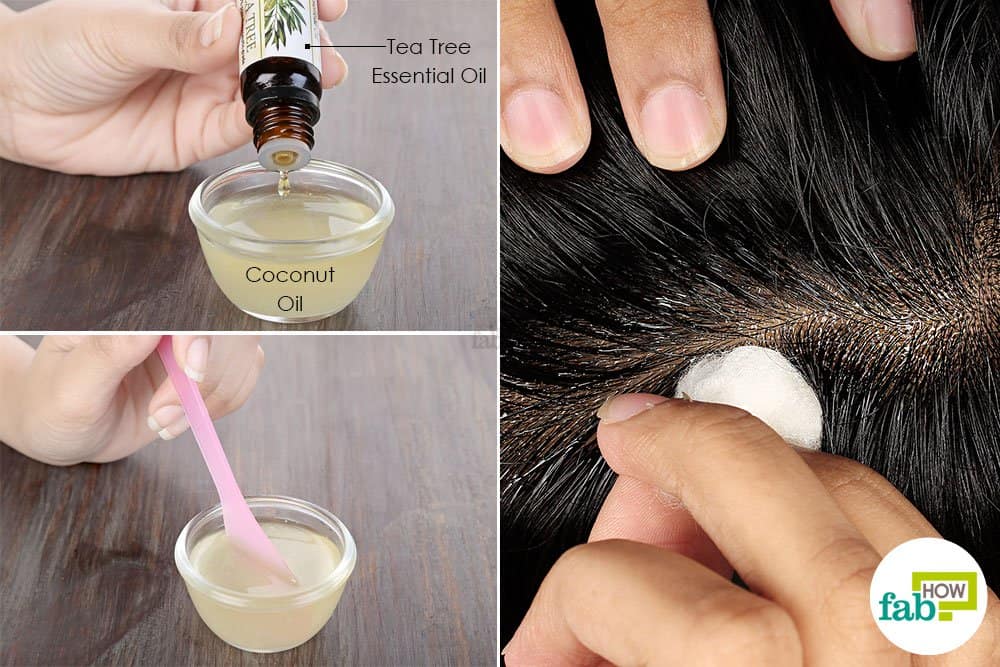
- Mix 10 drops of tea tree essential oil into 1 tablespoon of organic coconut oil.
- Soak a cotton ball in the solution and dab it onto your scalp to apply the oil blend. Make sure you cover all the dry and itchy patches.
- Leave it on for at least 30 minutes. You can also leave it on overnight.
- Wash it out with a mild shampoo and apply a conditioner.
Apply this oil blend 2 or 3 times a week to get rid of dandruff and an itchy scalp in 1 to 2 weeks.
Method 4: Cold, Cough and Sinus Congestion
Almost everyone suffers from a cold and cough at some point in time. Instead of popping pills, try using tea tree oil to get rid of the invading pathogens and also to loosen up the congestion. (4)
Common cold and cough can sometimes convert into a sinus infection. The infection results from the inflammation of the air pockets in your nose. Once inflamed, these pockets tend to swell up and fill up with fluids, leading to a stuffy nose and congestion. Another way to use tea tree oil for bacterial infections is in the form of vapors or steam.
When inhaled in the form of vapor, tea tree oil will reach the inflamed air pockets and kill the microorganisms invading the nasal cavity to treat common cold and cough as well as sinus congestion.
Single-Step Treatment: Add tea tree oil to hot water & inhale the steam
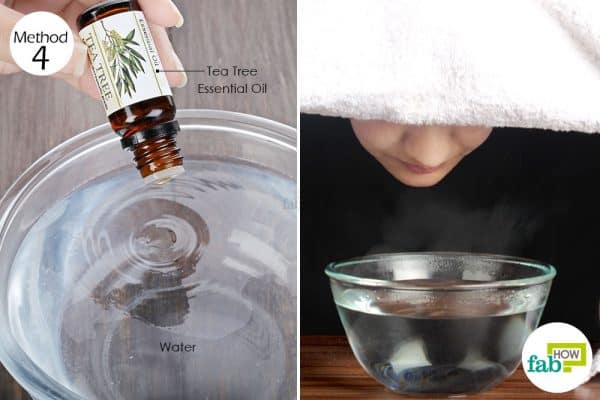
- Fill a large bowl with piping hot distilled water and add 8 to 10 drops of tea tree essential oil to it.
- Use a towel to make a tent around your head, and put your face above the bowl so the steam can enter your nose. Keep your eyes shut and maintain enough distance from the bowl so that you don’t burn yourself.
- Inhale the steam through your nose and exhale through your mouth. Continue this breathing for 10 minutes or until the water stops steaming.
Repeat 3 times a day for 1 week to get rid of a cold and cough and to open up your sinuses.
Method 5: Hidradenitis Suppurativa (Acne Inversa)
Hidradenitis suppurativa, also known as acne inversa, is an inflammatory skin disease that affects the sweat glands and hair follicles. It leads to painful red bumps or pus-filled sores in sweat-prone areas like the armpits, groin, under the breasts and the anal area.
Just like tea tree oil can effectively control common acne, it can also be used to treat acne inversa. The antibacterial oil will kill the invading pathogens in the sores and also help reduce the pus odor. (2) You’ll need to dilute it with a mild body lotion to apply it safely on the skin.
Things you’ll need:
- Tea tree essential oil (antibacterial) – 3 or 4 drops
- Mild body lotion (carrier) – 2 teaspoons
Single-Step Treatment: Mix tea tree oil in body lotion & apply it on the affected skin

- Mix 3 or 4 drops of tea tree essential oil into 2 teaspoons of a mild body lotion.
- Apply it on the affected skin. You need not wipe it off, as it will absorb into the skin.
Repeat 2 or 3 times daily until the acne inversa heals completely.
Method 6: Cellulitis
Cellulitis is an infection resulting from bacteria invading deep into your skin through a cut or wound and infecting the underlying tissue. It is characterized by redness of the skin along with pain and tenderness.
Tea tree oil can work against even the most resistant types of bacteria and is an effective treatment for cellulitis. (3) You need to mix it in honey before applying it. Raw and organic varieties of honey also will work as an antibacterial agent as well as seal the wound to prevent further infections.
Things you’ll need:
- Tea tree essential oil (antibacterial) – 20 drops
- Organic honey (antibacterial, heals wounds) – 1 tablespoon
Single-Step Treatment: Combine honey and tea tree oil & apply it on the infected skin

- Mix 20 drops of tea tree essential oil into 1 tablespoon of organic honey.
- Apply a thick layer of the blend on the affected skin.
- Leave it on for 30 minutes, then rinse it off with cold water.
Repeat twice daily for at least 1 week or until the skin is healed completely.
Method 7: Blepharitis
Blepharitis is an inflammatory condition that causes the edges of your eyelids to become red and swollen. It usually develops as a result of clogged oil pores in your eyelids or poor hygiene. Tea tree oil is touted as an effective remedy for this troubling condition. (7) The essential oil also helps kill the Demodex mites residing on your eyelids that contribute to the inflammation.
The coconut oil used as the carrier oil helps moisturize the flaky skin, unclog pores and act as a barrier to prevent infections.
Things you’ll need:
- Tea tree essential oil (antimicrobial) – 3 or 4 drops
- Coconut oil (moisturizes skin) – 2 tablespoons
Step 1. Dilute tea tree oil with coconut oil
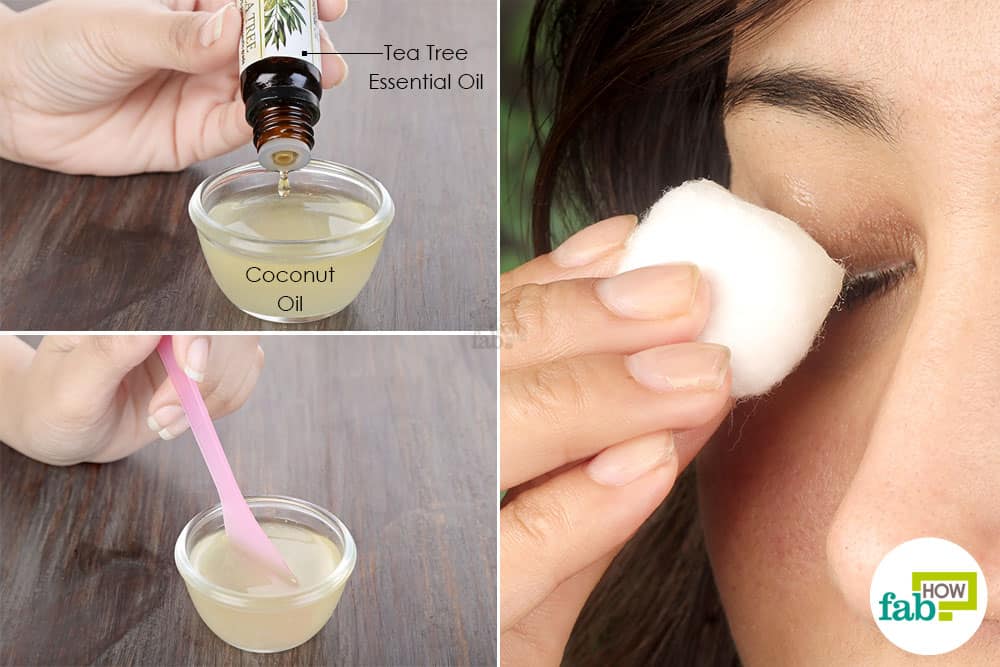
- Put 2 tablespoons of coconut oil in a bowl.
- Add 3 or 4 drops of tea tree essential oil.
- Mix the two thoroughly.
- Dip a cotton ball into the oil blend.
- Close your eyes and use the soaked cotton ball to gently wipe the oil blend over one eyelid. Discard the cotton ball after one use.
- Repeat the same procedure for the other eye using a fresh cotton ball.
- Leave it on for 1 to 2 minutes, then wash it off with cold water.
Repeat twice daily until the infection clears up. It may take 4 to 5 days, depending on the severity.
Method 8: Abscesses and Boils
Tea tree oil can be combined with turmeric, baking soda, and coconut oil to form a poultice to drain an abscess or get rid of a boil. Both tea tree oil and turmeric are powerful disinfectants that will kill off the invading bacteria. (5) Baking soda and coconut oil will help shrink the abscess by reducing the inflammation.
Things you’ll need:
- Turmeric powder (antibacterial) – 2 teaspoons
- Tea tree essential oil (disinfectant) – 15 drops
- Baking soda (anti-inflammatory) – 2 teaspoons
- Coconut oil (anti-inflammatory) – 2 teaspoons
Step 1. Combine the four ingredients
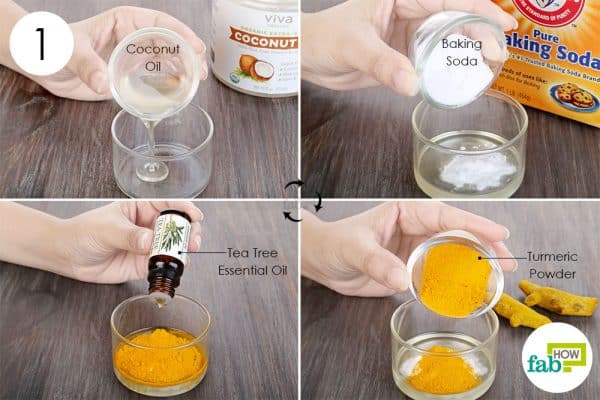
- Put 2 teaspoons of coconut oil in a bowl.
- Add 2 teaspoons each of baking soda and turmeric powder to it.
- Add 15 drops of tea tree oil as well.
Step 2. Mix well & apply it on the abscess or boil

- Using a spoon, mix all the ingredients well to get a consistent paste.
- Apply the paste to the abscess or boil using a clean cotton swab.
- Cover the area with a bandage or gauze to prevent turmeric stains.
- Leave it on for 2 to 3 hours, then rinse it off with warm water.
Repeat 3 times daily until the abscess or boil drains out completely and the skin begins to heal.
Method 9: Impetigo (bacterial)
Impetigo is a highly contagious skin infection caused in children by the Streptococcus pyogenes (strep) and Staphylococcus aureus (staph) bacteria. It is characterized by red sores primarily on the face and also on the neck, hands, and feet. The antibacterial nature of tea tree oil can help kill the bacteria embedded in the sores. Plus, it will prevent the infection from spreading. (3)
Things you’ll need:
- Olive oil (carrier) – 1 tablespoon
- Tea tree oil (antibacterial) – 5 or 6 drops
Single-Step Treatment: Mix tea tree oil in olive oil and apply on the sores

- Add 5 or 6 drops of tea tree oil to 1 tablespoon of olive oil.
- Mix well.
- Apply the blend on the affected area using a cotton swab. Use a fresh cotton swab for applying it to each sore.
- Leave it on for 20 to 30 minutes, then rinse it off with tepid water.
Repeat 2 or 3 times daily to see positive results in 4 to 5 days.
Tips to use tea tree oil for bacterial infections
- Since tea tree oil is a volatile oil, store it in a dark and cool place to maintain its efficacy.
- Always dilute tea tree oil before applying it to your skin.
- If the oil causes any redness or unbearable irritation, wash it off immediately.
- Tea tree oils are available in different concentrations. Buy 100% pure oil when using tea tree oil for bacterial infections.
Resources:
- Vito MD, Fracchiolla G, Mattarelli P, et al. Probiotic and Tea Tree Oil Treatments Improve Therapy of ... Medical Journal of Obstetrics and Gynecology. https://www.researchgate.net/publication/309809350. Published November 2016.
- Graber, E. Treatment of acne vulgaris. UpToDate. https://www.uptodate.com/contents/treatment-of-acne-vulgaris?search=tea tree oil&source=search_result&selectedTitle=5~14&usage_type=default&display_rank=5. Published October 2018.
- Hartman-Adams H, Banvard C, Juckett G. Impetigo: Diagnosis and Treatment. AAFP Home. https://www.aafp.org/afp/2014/0815/p229.html. Published August 15, 2014.
- Horváth G, Ács K. Essential oils in the treatment of respiratory tract diseases highlighting their role in bacterial infections and their anti‐inflammatory action: a review. The Canadian Journal of Chemical Engineering. https://onlinelibrary.wiley.com/doi/full/10.1002/ffj.3252. Published May 26, 2015.
- Kremsreiter A. Tea Tree Oil as an Agent for MRSA Decolonization. Semantic Scholar. https://www.semanticscholar.org/paper/Tea-Tree-Oil-as-an-Agent-for-MRSA-Decolonization-Kremsreiter/f824d89f9be8d80192bc581438f249fb4f768d1d. Published 2016.
- S, N, S K, R, S, R, M, A M. In-vitro evaluation of herbal and chemical agents in the ... Journal of Microbiology and Biotechnology Research. https://jmbronline.com/index.php/JMBR/article/view/216. Published 2012.
- Shtein, RM. Blepharitis. UpToDate. https://www.uptodate.com/contents/blepharitis?search=tea tree oil&source=search_result&selectedTitle=4~14&usage_type=default&display_rank=4. Published April 2018.









